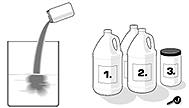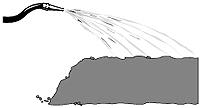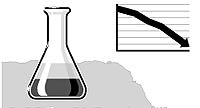Treating Drums of Old Oil-Dri With Oettco Bioremediation Materials To Eliminate Absorbed Petroleum Wastes
Oettco Products Corp., 3296 Montara Drive, Bonita Springs, FL 33923, USA 941-498-0771
Oettco Products Corp. offers a kit containing all the bioremediation materials
necessary to treat up to 30 fifty-gallon drums full of old Oil-Dri, Kitty Litter
or similar clay absorbents that have been used to soak up spilled petroleum.
This method of bioremediation is dramatically less expensive than traditional
methods of disposing of such wastes.
Your Basic Situation: you have fifty-gallon drums full of absorbent clay
products that have been used to soak up spilled petroleum (below, left). Your
Goal: to lower the Total Petroleum Hydrocarbon (TPH) parts-per-million (ppm)
level in the most economic manner possible, turning the polluted clay absorbent
into clean fill.

Step 1: Dump out the contents of the drums. The material is emptied onto
flat ground where it is formed into a level pile 12 inches high (above, right).
Up to 30 drums can be dumped out and formed into a pile.

Step 2: Mix the three ingredients of dry microbes, nutrients and biological
catalysts according to the simple, fully illustrated instructions. The end result
is a single solution that can be applied with an appropriate industrial sprayer.
This solution should be used within two hours of mixing.

Step 3: Apply the bioremediation solution to the pile of clay material and
use an appropriate mechanical means to ensure as even a distribution as possible
throughout the entire pile. You can use shovels if you have the manpower available
or you can use a device like a roto-tiller.
Step 4: Re-treat the pile twice in 60 days with a spray of nutrients, biological
catalysts and water. A total of three spray and till applications are performed
on the pile during a 60 days period: the initial application with microbes,
nutrients and biological catalysts; a second application at 30 days of nutrients
and biological catalysts; and a third application at 60 days of nutrients and
biological catalysts. The kit contains enough materials for all three treatments.

Step 5: Keep the pile damp (above) throughout the entire term of bioremediation.
You want it to be moist to the touch, but not muddy or soupy. Water is critical
to sustain microbial action but TOO much water fills all air spaces within the
particulate, thus blocking the constant passage of air required to replenish
depleted oxygen levels below the surface.

Step 6: Monitor what is �happening in your pile with standard sampling and
TPH lab analysis methods. The actual speed of biodegradation varies according
to the type, age, viscosity and concentration of hydrocarbons present, as well
as the specific site conditons. It normally takes 90 to 150 days to achieve
dramatic reductions in hydrocarbon levels throughout the pile.





